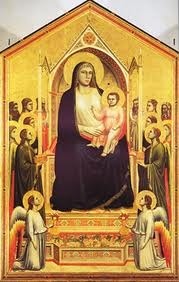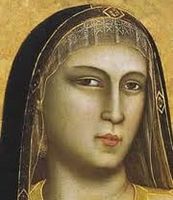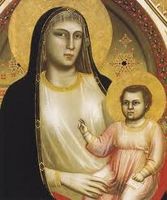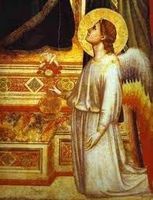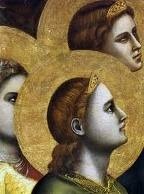Ognissanti Madonna Analysis
- Date of Creation:
- 1310
- Height (cm):
- 325.00
- Length (cm):
- 204.00
- Medium:
- Tempera
- Support:
- Wood
- Subject:
- Figure
- Art Movement:
- Renaissance
- Created by:
- Current Location:
- Florence, Italy
- Ognissanti Madonna Analysis Page's Content
- Composition
- Use of color
- Use of Light
- Mood, Tone and Emotion
Ognissanti Madonna Composition
Giotto di Bondone's rendering of the Maestà, in this case the Ognissanti Madonna, was thematically identical to many other works in his time completed by other artists: the very definition of the Maestà, so popular during di Bondone's lifetime, was an enthroned Virgin holding the infant Jesus and surrounded by adoring angels and saints.
Religion was a universally popular theme, particularly that of the Holy Virgin and her central role in Roman Catholicism as the mother of Christ. However, theme is virtually the only similarity between di Bondone's Maestà and other artists'.
Compositionally, di Bondone broke the mold with his Ognissanti Madonna. First, he arranges the supporting figures - the angels and saints - in a group on either side of the throne, standing as they would naturally. Some faces are obscured or partially blocked as would be normal if the scene were viewed from the front.
The Byzantine tradition dictated the surrounding figures be "stacked" rather unnaturally on either side of the throne, forming a vertical line with each head a little higher than the one beneath it so that all could be seen. Clearly, this is impossible in reality with every angel/saint standing naturally.
The Madonna is another of di Bondone's compositional deviations from Medieval methods. Instead of painting her as a light, almost weightless-looking, flowing figure without angles or straight lines, di Bondone creates a large, imposing figure that towers over the other figures in the painting.
She looks almost intimidating, and the traditional demure look has been replaced by regal pride. In contrast to this, however, she tenderly grasps her baby's leg in a gesture of protectiveness.
Ognissanti Madonna Use of color
As in all his paintings, and again in easy defiance of the traditions of the time, di Bondone chose bright, lively colors over the largely monochromatic (gold) religious paintings of his predecessors. Although he does use gold to bathe the painting in ethereal light, the rest of the painting is true to reality.
For example, replacing the angels' typically colorless, formless robes are lovely reds and greens with real texture and movement, falling realistically over arms and shoulders. Similarly, the wings of the angels at the bottom of the painting are not painted a dull off-white or gold but appear to reflect the brilliant heavenly light from above, creating an orange, red, and gold shine that matches the throne perfectly.
The throne, which gives the impression of both vastness and fragility, is painted in red and green geometric shapes that match the angels' robes.
Moving inward, the imposing figure of the Madonna takes on a different feeling altogether by di Bondone's use of stark blackness in her clothing. The black stands in contrast to her regal and holy status but effectively draws attention to her vastness and centrality to the painting. The infant Jesus, on the other hand, is clothed in a light, almost sheer pink tunic that suggests innocence and sweetness.
Ognissanti Madonna Use of Light
The only source of light in the Ognissanti Madonna comes from above, a celestial glow that inundates the atmosphere with brightness and a sense of joy. The shadows beneath the Madonna's breasts, for example, confirm the light's origin.
Heavenly light was common in Maestà paintings, as it helped add to the overall "holiness" of the picture.
Di Bondone was exceptionally skilled at creating a seemingly real environment, paying close attention to the tiniest details that made his subjects and scenes come alive. Instead of simply adding the light source and leaving it at that, di Bondone meticulously perfected his shading so that his subjects would appear to be standing in a ray of holy light.
Ognissanti Madonna Mood, Tone and Emotion
The burgeoning popularity of the cult of the Holy Virgin in turn made the Maestà a hugely popular theme for artists of di Bondone's time. Eager to demonstrate piety and devotion, voluminous amounts of time were spent perfecting these paintings which often hung in places of honor in churches throughout Italy and all Christendom.
As di Bondone harbored a similar piety and a devotion to the Franciscan church, he created this Maestà with a strong tone of reverent joy. The face of the Madonna radiates warmth underneath her stern exterior, and the angels and saints below her gaze upward in awe, respect, joy and slight trepidation.
The painting as a whole emanates a unique optimism, making the viewer feel as though he or she is viewing a scene of celebration rather than a subdued, still-life picture of religious figures.

